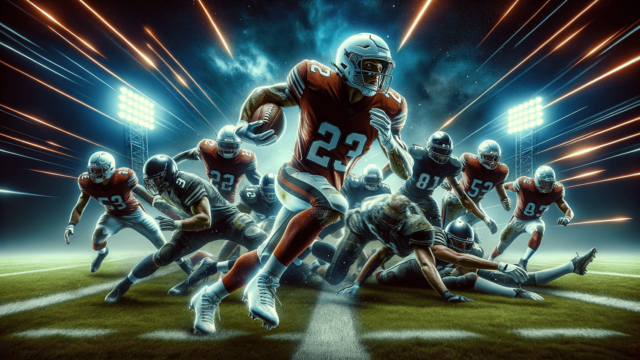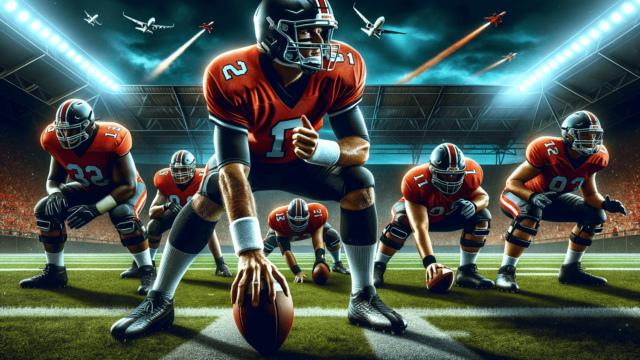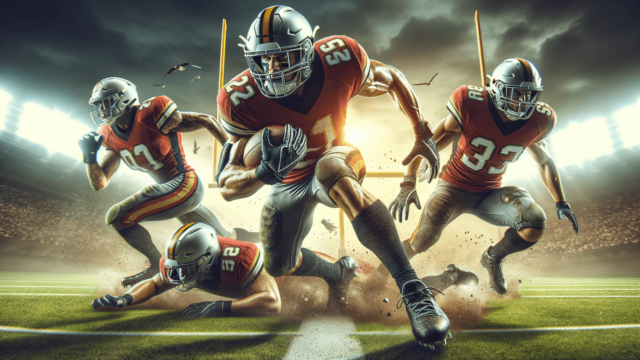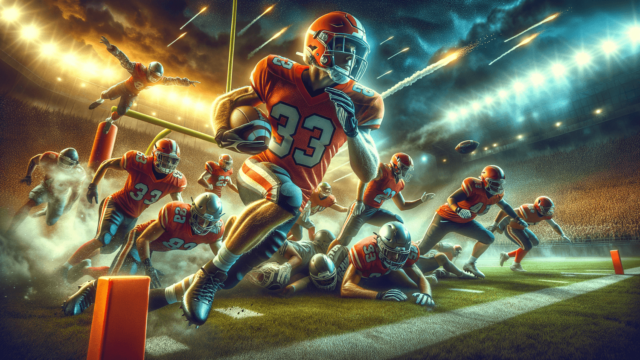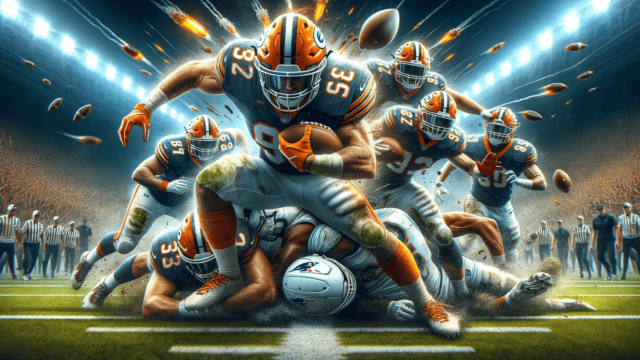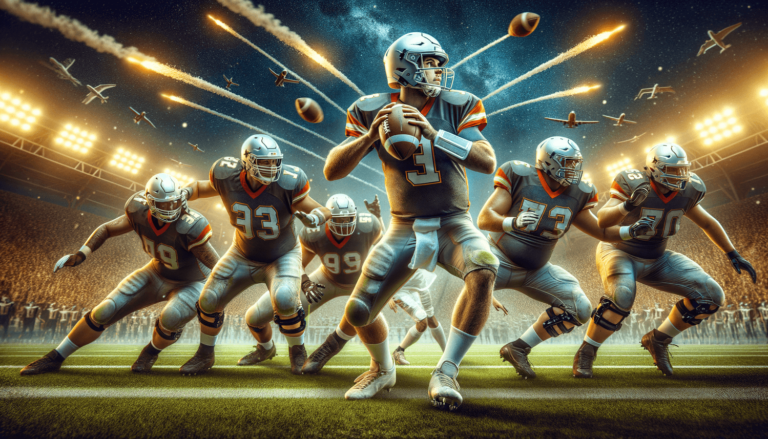
The pocket in football is a protected area formed by the offensive linemen, allowing the quarterback to comfortably stand, read the defense, and execute passing plays without getting tackled. The offensive line creates a semi-circular buffer around the quarterback, which is vital for the success of the pass game.
Understanding the Pocket in Football
The pocket in football is a crucial element of any successful passing game. It is a protected area formed by the offensive line, allowing the quarterback to focus on passing without being immediately tackled by defensive players.
Formation of the Pocket
The pocket takes shape when the offensive linemen maintain their blocking assignments, preventing oncoming pass rushers from reaching the quarterback. This semi-circular buffer provides the quarterback with the necessary space and time to execute the play.
Offensive Line’s Role
The center, guards, and tackles work together to create the pocket. They hold their positions and bridge the gap between them, using superior footwork, strength, and technique to control the defenders. Just as important for the pass success is the cohesion and communication regarding blocking schemes.
Quarterback’s Responsibilities
While the offensive line creates the pocket, the quarterback must skillfully navigate within it to maintain protection.
Maintaining Awareness and Vision
Whether dropping back from under center or in a shotgun formation, the quarterback’s awareness of the pocket’s dimensions is vital. This allows them to recognize when the pocket collapses and evade pressure by stepping up into it or rolling out to escape defenders.
Quick Decision-Making
Understanding the time constraints and potential threats to the pocket’s integrity is crucial. It requires the quarterback to make quick yet accurate decisions on when to throw, scramble, or even take a sack to avoid further complications.
Defensive Strategies to Disrupt the Pocket
As important as the pocket is to the offensive game, defenses will work tirelessly to disrupt its formation and break it down.
Pass Rush Techniques
Defensive linemen and linebackers will target the weak links in the offensive line using a mix of speed, strength, and agility to penetrate the pocket and apply pressure on the quarterback. Advanced techniques and stunts will also be used to overwhelm the protection and cause chaos.
Blitz Packages
To generate additional pressure, defenses employ blitz packages strategically, overwhelming the offensive line with more rushers than can be effectively blocked. This forces the quarterback to make hasty decisions, often leading to turnovers or incompletions.
Importance of the Pocket in Football
The pocket’s importance lies not only in guaranteeing the quarterback’s safety but also in bolstering the overall effectiveness of a team’s passing game. An efficient pocket allows the quarterback to effectively execute the designed play and exploit defensive weaknesses.
Evolution of the Pocket over Time
As football strategies have evolved, so has the role of the pocket, leading to changes in offensive and defensive approaches.
Emphasis on Athleticism
While strong, immovable linemen were once valued for their ability to maintain a stable pocket, today’s game places a premium on agility and quickness. This shift ensures the offensive line can adapt and react to increasingly agile pass rushers attempting to penetrate the pocket.
Changes in Blocking Techniques
Offensive lines have adapted their techniques to counteract complex defensive schemes. Improved hand placement, stance, and more advanced blocking assignments have led to better pocket protection around versatile quarterbacks.
Mobile Quarterbacks
Today’s offenses increasingly feature quarterbacks with the ability to extend plays with their legs, creating additional challenges for defensive players attempting to disrupt the pocket. Mobile quarterbacks can not only escape collapsing pockets with ease but also add an extra running threat, forcing defenses to account for this during game planning.
Tips to Strengthen Pocket Protection
Both coaches and players can implement strategies to improve the pocket’s integrity during games.
Reinforcing Offensive Line Fundamentals
Coaches should emphasize the importance of footwork, hand placement, and communication during practices. Well-trained offensive linemen can better protect the pocket and adjust to different defensive schemes.
Developing Quarterback Awareness
Developing a quarterback’s sense of timing and pocket awareness is fundamental to the passing game’s effectiveness. Drills that simulate pressure, teaching the quarterback when to release the ball or where to move inside the pocket, can make a significant impact on the overall success of the offense.
Quick Passing Game
Another approach to strengthen the pocket protection is to emphasize quick throws in the offensive game plan. Utilizing short, quick routes and faster-developing plays minimizes the time the offensive line has to maintain the pocket and lessens the impact of a pass rush.
FAQ Section: Pocket in Football
After reading about the pocket in football, you may have some additional questions. We’ve compiled a list of frequently asked questions to provide further insights and enhance your understanding of this essential aspect of the game.
1. Can a quarterback be considered successful without a strong pocket?
While a solid pocket is important, some quarterbacks can compensate for a weaker pocket with mobility or quick decision-making. However, a strong pocket undoubtedly increases the likelihood of consistent success for any quarterback.
2. What is the impact of a collapsing pocket on the quarterback’s performance?
A collapsing pocket can negatively impact a quarterback’s performance by reducing the time available to make decisions, leading to rushed throws, interceptions, sacks, or forced scrambles. A consistent pass rush can also disrupt a quarterback’s confidence and rhythm during a game.
3. How can a defense successfully collapse the pocket?
Defenses can collapse the pocket by employing a combination of pass rush techniques, blitz packages, and overwhelming the offensive line with speed and strength. These tactics place pressure on the quarterback, potentially forcing them to make errors.
4. Are there any specific drills for quarterbacks to improve their pocket awareness?
Yes, various drills can help quarterbacks improve their pocket awareness. Drills like the “Three-Step Drop,” “Five-Step Drop,” and pressure simulation drills, can all enhance a quarterback’s ability to navigate the pocket, make quicker decisions, and avoid pressure from defenders.
5. Are there any famous examples of quarterbacks known for their exceptional pocket presence?
Several quarterbacks are renowned for their exceptional pocket presence, such as Tom Brady, Peyton Manning, and Dan Marino. Their ability to sense and evade pressure, quickly read defenses, and deliver accurate passes in tight spaces has earned them a place among the football greats.
Featured Posts
- No pillar pages found.
